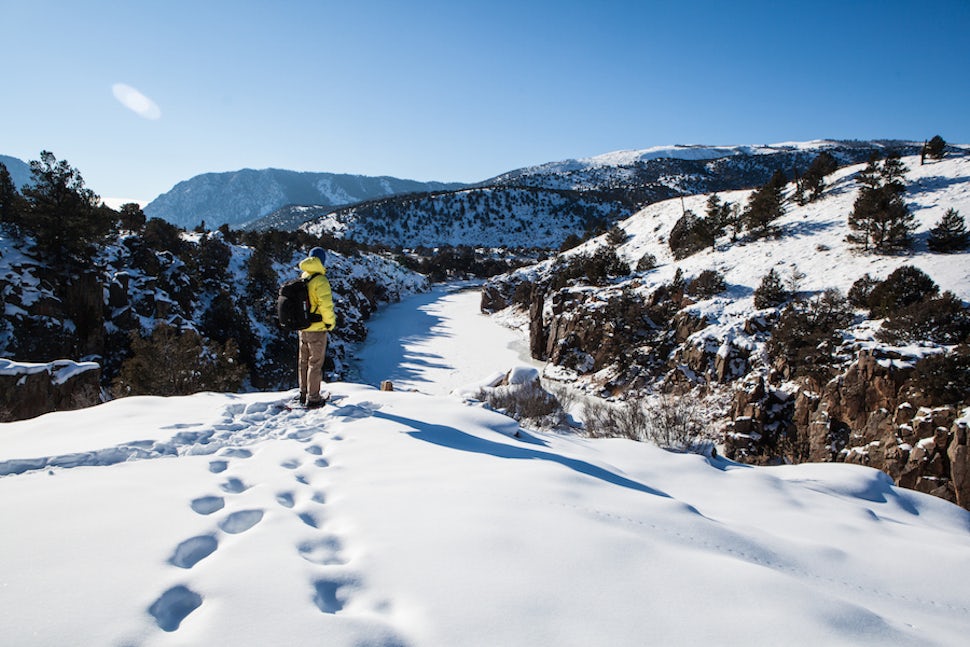Is This The Next Winter Activity You'll Try?

Claimed by some to be the fastest growing winter sport, snowshoeing is undeniably on the rise. And it’s no wonder—anyone can do it, the gear is inexpensive, the kids and dog can come along. Plus, it’s a killer workout; you burn up to 600 calories per hour! Whether you want to snowshoe to a backcountry hut, access hidden stashes of powder, or just take a walk in the woods, here are a few tips for getting started.
1. Warm on top, waterproof on bottom
Your snowshoe attire depends on the conditions. While it’s typically a moderate intensity activity, you might find yourself too warm for a resort jacket. Think breathable layers on top, paired with mandatory waterproof pants on bottom—you’ll soon find that your snowshoes have the tendency to kick snow upwards and all over the back of your legs. Gaiters are also a must-have for this activity, as you never know how deep the trail will be, or where your adventure might lead.
Now let’s talk about what’s on your feet. Snowshoes themselves differ largely in shape and form, and are constructed for a number of different conditions. If you plan on breaking trail 99% of the time, you’ll want a longer shoe to keep you afloat on powder. Shorter shoes with extra jaws help on icier, more packed down trails. Keep in mind when renting or purchasing that they’re also sized for your weight. Wear warm, waterproof boots you’ve already broken in, and throw some moleskin in your pack just in case.
2. To pole or not to pole
Whenever I use poles hiking or snowshoeing, I’m met with criticism. Apparently, these added appendages make me look like a big nerd (although that might have something to do with the gaiters). Regardless of my sense of style, poles help alleviate pressure on your knees and provide extra points of contact for slippery sections of trail. Bring a lightweight, collapsible pair and you’ll always have the option of attaching them to your pack.
3. Where to go
Great news—you’ve got options. First, almost all Nordic centers and parks in the U.S. have snowshoeing trails built into their system. You’ll need to purchase a day pass at these locations, but the accompanying trail map and hot chocolate at the lodge are a big plus. If you’re looking to break trail and do something a bit more adventurous (and calorie burning), think about taking to your favorite summer trails, or anything found here on The Outbound. These more off-the-grid spots will likely already be popular among snowshoers, but if you get there early, you’ve got a high chance of getting first tracks in fresh snow that is ridiculously fun to tromp through. Pack your own hot chocolate and snacks to make the experience a winning one!
4. Explore safely
Because snowshoeing often takes you to the trails less traveled by, make sure you understand basic avalanche dangers before you go. Check conditions and bring the proper gear, and if you don’t feel like you know what that means, steer clear of dangerous areas including things like obvious valleys and slopes. You can often check ahead on the area’s website to learn about the unique terrain and if avalanches are a risk.
Grab your snowshoes and check out winter hiking and snowshoeing adventures on The Outbound.
We want to acknowledge and thank the past, present, and future generations of all Native Nations and Indigenous Peoples whose ancestral lands we travel, explore, and play on. Always practice Leave No Trace ethics on your adventures and follow local regulations. Please explore responsibly!
Do you love the outdoors?
Yep, us too. That's why we send you the best local adventures, stories, and expert advice, right to your inbox.










